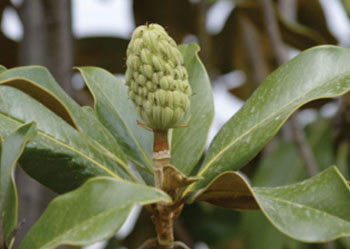Honokiol Prevents Hypertrophy in Mice by Increasing Mitochondrial Sirt3 Activity
By LabMedica International staff writers
Posted on 27 Apr 2015
The ancient herbal therapy substance honokiol, which is derived from the bark, seed cones, and leaves of trees belonging to the genus Magnolia, has been found in a recent study to have chemical properties that enable it to protect the heart from hypertrophy.Posted on 27 Apr 2015
Honokiol is a natural biphenolic compound with anti-inflammatory, anti-oxidative, anti-tumor, and neuroprotective properties that can readily cross the blood brain barrier and the blood-cerebrospinal fluid barrier. As a result, it is a potentially potent therapeutic agent with high bioavailability.

Image: Seed cone from Magnolia grandiflora, a primary source of honokiol (Photo courtesy of Wikimedia Commons).
Investigators at the University of Chicago (IL, USA) worked with a mouse model of cardiac hypertrophy. They reported in the April 14, 2015, online edition of the journal Nature Communications, that when injected into mice, honokiol reduced the excess growth of individual cardiac muscle cells, decreased ventricular wall thickness, and prevented the accumulation of interstitial fibrosis, a stiffening of cardiac muscle cells that reduces their ability to contract. The compound also protected heart muscle cells from the damage caused by oxidative stress.
The data suggested that the anti-hypertrophic effects of honkiol depended on activation of the deacetylase Sirt3 (silent mating type information regulation 2 homolog) 3. The investigators demonstrated that honkiol was present in mitochondria where it enhanced Sirt3 expression nearly twofold. They suggested that honokiol might bind to Sirt3 to further increase its activity. Increased Sirt3 activity was associated with reduced acetylation of mitochondrial Sirt3 substrates, MnSOD and oligomycin-sensitivity conferring protein (OSCP).
Manganese superoxide dismutase (MnSOD) is the primary antioxidant enzyme that protects cells from oxidative stress by catalyzing dismutation of superoxide to hydrogen peroxide and oxygen in the mitochondria of eukaryotic cells.
Honokiol treatment increased mitochondrial rate of oxygen consumption and reduced ROS (reactive oxygen species) synthesis in wild type, but not in cells that lacked the gene for Sirt3. Moreover, honokiol-treatment blocked cardiac fibroblast proliferation and differentiation to myofibroblasts in a Sirt3-dependent manner.
"Honokiol, by increasing SIRT3 levels, effectively blocked both the induction and progression of cardiac hypertrophy in mice," said senior author Dr. Mahesh Gupta, professor of surgery at the University of Chicago. "It even mitigated preexisting cardiac hypertrophy. This has the potential to play a significant role in the prevention and treatment of heart failure. To the best of our knowledge, this is the first report to describe a pharmacologic activator of SIRT3. Until now, caloric restriction combined with endurance exercise has been the only way to boost SIRT3 levels. Very few people have been able to follow such a rigorous regimen."
Related Links:
University of Chicago














